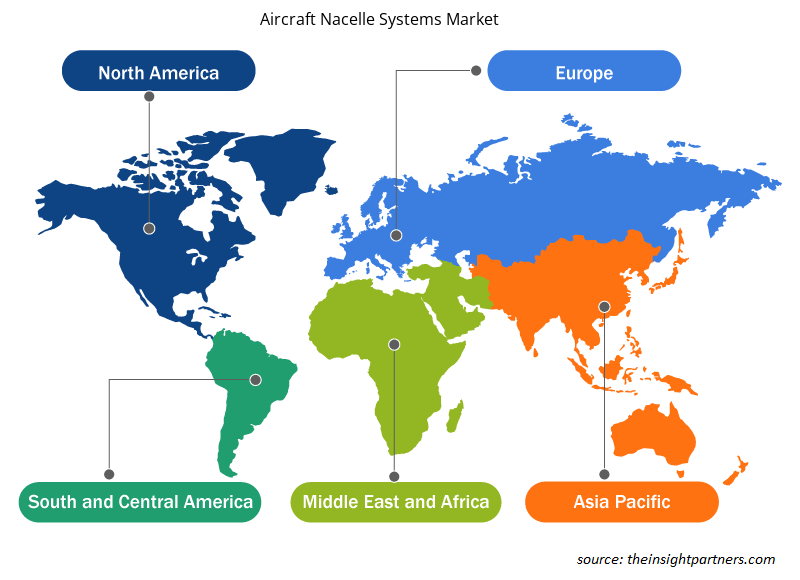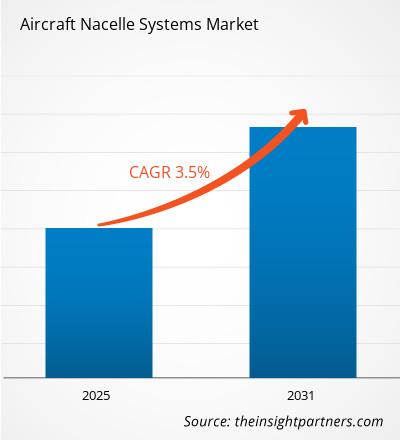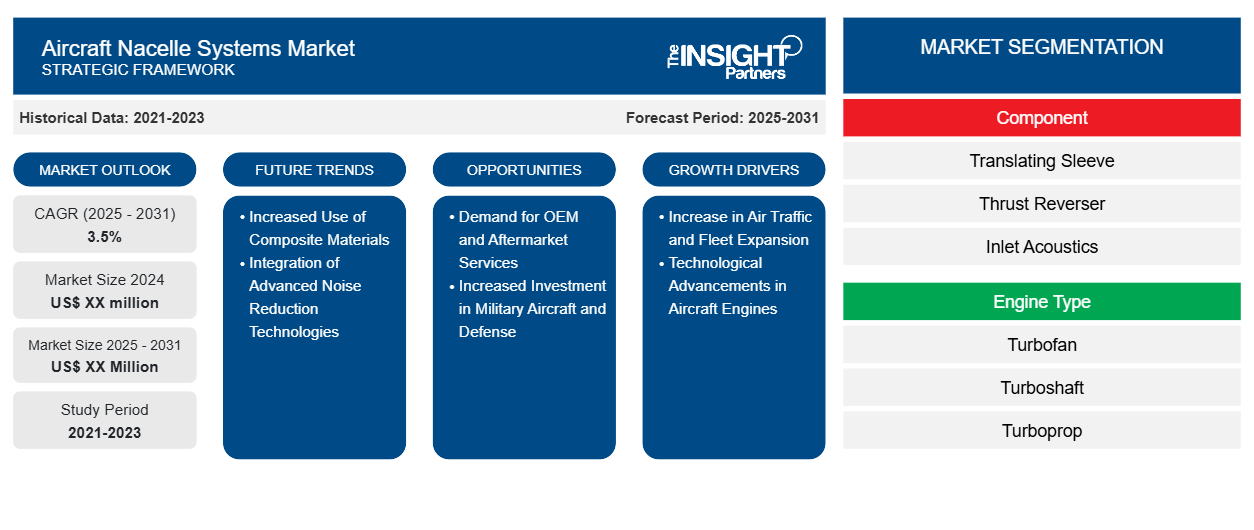Si prevede che il mercato dei sistemi di gondole aeronautiche registrerà un CAGR del 3,5% dal 2023 al 2031, con una dimensione di mercato in espansione da XX milioni di dollari nel 2023 a XX milioni di dollari entro il 2031.
Il report è segmentato per Componente (Manicotto di traslazione, Inversore di spinta, Acustica di ingresso, Cappucciatura ventola, Struttura fissa interna, Altri); Tipo di motore (Turbofan, Turboalbero, Turboelica); Uso finale (Aerei commerciali, Aerei regionali, Aviazione generale, Altri). L'analisi globale è ulteriormente suddivisa a livello regionale e nei principali paesi. Il report offre il valore in USD per l'analisi e i segmenti di cui sopra.
Scopo del rapporto
Il report Aircraft Nacelle Systems Market di The Insight Partners mira a descrivere il panorama attuale e la crescita futura, i principali fattori trainanti, le sfide e le opportunità. Ciò fornirà spunti a vari stakeholder aziendali, come:
- Fornitori/produttori di tecnologia: per comprendere le dinamiche di mercato in evoluzione e conoscere le potenziali opportunità di crescita, consentendo loro di prendere decisioni strategiche informate.
- Investitori: condurre un'analisi completa delle tendenze in merito al tasso di crescita del mercato, alle proiezioni finanziarie del mercato e alle opportunità esistenti lungo la catena del valore.
- Enti di regolamentazione: regolamentano le politiche e le attività di controllo sul mercato allo scopo di ridurre al minimo gli abusi, preservare la fiducia degli investitori e sostenere l'integrità e la stabilità del mercato.
Segmentazione del mercato dei sistemi di gondole aeronautiche
Componente
- Manica traduttrice
- Invertitore di spinta
- Acustica di ingresso
- Cappuccio del ventilatore
- Struttura fissa interna
- Altri
Tipo di motore
- Turboventola
- Turboalbero
- Turboelica
Uso finale
- Aereo commerciale
- Aerei regionali
- Aviazione generale
- Altri
Geografia
- America del Nord
- Europa
- Asia-Pacifico
- America del Sud e Centro
- Medio Oriente e Africa
Geografia
- America del Nord
- Europa
- Asia-Pacifico
- America del Sud e Centro
- Medio Oriente e Africa
Personalizza questo report in base alle tue esigenze
Riceverai la personalizzazione gratuita di qualsiasi report, comprese parti di questo report, o analisi a livello nazionale, pacchetto dati Excel, oltre a usufruire di grandi offerte e sconti per start-up e università
-
Scopri le principali tendenze di mercato in questo rapporto.Questo campione GRATUITO includerà analisi di dati che spaziano dalle tendenze di mercato alle stime e alle previsioni.
Driver di crescita del mercato dei sistemi di gondole aeronautiche
- Aumento del traffico aereo ed espansione della flotta: l'aumento globale del traffico aereo e l'espansione delle flotte commerciali, cargo e militari sono fattori trainanti significativi per il mercato dei sistemi di gondole. Man mano che le compagnie aeree e le organizzazioni di difesa acquisiscono nuovi aeromobili, aumenta la domanda di sistemi di gondole per supportare tecnologie di motori avanzate. La crescente necessità di aeromobili più efficienti, silenziosi e a basso consumo di carburante sta aumentando la domanda di sistemi di gondole avanzati in grado di ospitare gli ultimi modelli di motori.
- Progressi tecnologici nei motori aeronautici: lo sviluppo di motori più efficienti nei consumi e più potenti, come i motori turbofan a ingranaggi (GTF) e i motori a rotore aperto, sta guidando la domanda di sistemi di gondole innovativi. Questi motori richiedono gondole che possano adattarsi alle loro dimensioni, peso e caratteristiche aerodinamiche uniche, mantenendo efficienza e sicurezza. Man mano che le tecnologie dei motori si evolvono, anche i sistemi di gondole devono progredire, creando domanda di nuovi design e materiali che ottimizzino le prestazioni.
Tendenze future del mercato dei sistemi di gondole aeronautiche
- Maggiore utilizzo di materiali compositi: la tendenza all'utilizzo di materiali compositi leggeri nei sistemi di navicella è in crescita. I compositi, come la fibra di carbonio e la fibra di vetro, offrono diversi vantaggi rispetto ai materiali metallici tradizionali, tra cui peso ridotto, migliore efficienza nei consumi e resistenza alla corrosione. La continua spinta dell'industria aerospaziale verso aeromobili più leggeri e più efficienti nei consumi porterà a una maggiore adozione di componenti di navicella in composito, offrendo prestazioni migliorate e costi operativi ridotti.
- Integrazione di tecnologie avanzate di riduzione del rumore: poiché la riduzione del rumore continua a essere una priorità a causa di preoccupazioni ambientali e pressioni normative, si prevede che lo sviluppo di tecnologie avanzate di riduzione del rumore nei sistemi di gondole aumenterà. I produttori si stanno concentrando sulla creazione di gondole con capacità di soppressione del rumore migliorate, utilizzando materiali e design che riducono al minimo il rumore del motore, come rivestimenti acustici e configurazioni avanzate delle gondole acustiche. Questa tendenza crescerà man mano che le compagnie aeree si sforzeranno di soddisfare normative più severe sul rumore e migliorare il comfort dei passeggeri.
Opportunità di mercato per i sistemi di navicelle aeronautiche
- Domanda di servizi OEM e aftermarket: la domanda di sistemi nacelle non è guidata solo dalla produzione di nuovi aeromobili, ma anche dalla crescente necessità di servizi aftermarket. I servizi di manutenzione, riparazione e revisione (MRO) sono essenziali per garantire le prestazioni e la sicurezza continue dei sistemi nacelle durante l'intero ciclo di vita di un aeromobile. Con la continua espansione della flotta globale, la domanda di servizi MRO nacelle, tra cui ispezione, riparazioni e sostituzione dei componenti, creerà opportunità significative per le aziende nel mercato delle nacelle.
- Maggiori investimenti in aeromobili militari e difesa: il settore degli aeromobili militari è un altro settore in cui ci sono opportunità per i produttori di sistemi di gondole. Con l'aumento dei budget per la difesa e lo sviluppo di aeromobili militari avanzati, c'è una crescente necessità di sistemi di gondole specializzati che possano ospitare motori di livello militare e tecnologie di propulsione. Questi aeromobili spesso richiedono soluzioni di gondole più robuste e ad alte prestazioni, in particolare nelle aree delle capacità stealth e dell'efficienza del motore.
Approfondimenti regionali sul mercato dei sistemi di navicelle per aeromobili
Le tendenze regionali e i fattori che influenzano il mercato dei sistemi di navicelle aeronautiche durante il periodo di previsione sono stati ampiamente spiegati dagli analisti di Insight Partners. Questa sezione discute anche i segmenti e la geografia del mercato dei sistemi di navicelle aeronautiche in Nord America, Europa, Asia Pacifico, Medio Oriente e Africa e America meridionale e centrale.

- Ottieni i dati specifici regionali per il mercato dei sistemi di navicella aeronautica
Ambito del rapporto di mercato sui sistemi di navicelle per aeromobili
| Attributo del report | Dettagli |
|---|---|
| Dimensioni del mercato nel 2023 | XX milioni di dollari USA |
| Dimensioni del mercato entro il 2031 | XX milioni di dollari USA |
| CAGR globale (2023-2031) | 3,5% |
| Dati storici | 2021-2022 |
| Periodo di previsione | 2024-2031 |
| Segmenti coperti |
Per componente
|
| Regioni e Paesi coperti |
America del Nord
|
| Leader di mercato e profili aziendali chiave |
|
Densità dei player del mercato dei sistemi di navicelle aeronautiche: comprendere il suo impatto sulle dinamiche aziendali
Il mercato Aircraft Nacelle Systems Market sta crescendo rapidamente, spinto dalla crescente domanda degli utenti finali dovuta a fattori quali l'evoluzione delle preferenze dei consumatori, i progressi tecnologici e una maggiore consapevolezza dei vantaggi del prodotto. Con l'aumento della domanda, le aziende stanno ampliando le loro offerte, innovando per soddisfare le esigenze dei consumatori e capitalizzando sulle tendenze emergenti, il che alimenta ulteriormente la crescita del mercato.
La densità degli operatori di mercato si riferisce alla distribuzione di aziende o società che operano in un particolare mercato o settore. Indica quanti concorrenti (operatori di mercato) sono presenti in un dato spazio di mercato in relazione alle sue dimensioni o al valore di mercato totale.
Le principali aziende che operano nel mercato dei sistemi di gondole aeronautiche sono:
- Cadenza Aerospaziale, LLC
- Del Ponte
- Aviazione GE
- La Gulfstream Aerospace Corp.
- Aviazione Kawak
Disclaimer : le aziende elencate sopra non sono classificate secondo un ordine particolare.

- Ottieni una panoramica dei principali attori del mercato dei sistemi di gondole aeronautiche
Punti di forza chiave
- Copertura completa: il rapporto copre in modo completo l'analisi di prodotti, servizi, tipologie e utenti finali del mercato dei sistemi di gondole aeronautiche, fornendo una panoramica olistica.
- Analisi degli esperti: il rapporto è compilato sulla base della conoscenza approfondita di esperti e analisti del settore.
- Informazioni aggiornate: il rapporto garantisce la pertinenza aziendale grazie alla copertura di informazioni recenti e tendenze nei dati.
- Opzioni di personalizzazione: questo report può essere personalizzato per soddisfare le esigenze specifiche del cliente e adattarsi in modo appropriato alle strategie aziendali.
Il rapporto di ricerca sul mercato dei sistemi di navicelle aeronautiche può, quindi, aiutare a guidare il percorso di decodifica e comprensione dello scenario del settore e delle prospettive di crescita. Sebbene possano esserci alcune preoccupazioni valide, i vantaggi complessivi di questo rapporto tendono a superare gli svantaggi.
- Analisi storica (2 anni), anno base, previsione (7 anni) con CAGR
- Analisi PEST e SWOT
- Valore/volume delle dimensioni del mercato - Globale, Regionale, Nazionale
- Industria e panorama competitivo
- Set di dati Excel
Report recenti
Rapporti correlati
Testimonianze
Motivo dell'acquisto
- Processo decisionale informato
- Comprensione delle dinamiche di mercato
- Analisi competitiva
- Analisi dei clienti
- Previsioni di mercato
- Mitigazione del rischio
- Pianificazione strategica
- Giustificazione degli investimenti
- Identificazione dei mercati emergenti
- Miglioramento delle strategie di marketing
- Aumento dell'efficienza operativa
- Allineamento alle tendenze normative























 Ottieni un campione gratuito per - Mercato dei sistemi di navicelle aeronautiche
Ottieni un campione gratuito per - Mercato dei sistemi di navicelle aeronautiche